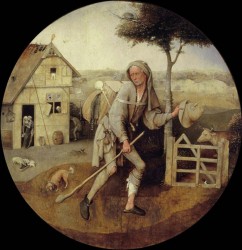
Peeters 1968
“Rondom een paar thema’s bij Jeroen Bosch” (Raym. Peeters) 1968
[in: Taxandria, N.R. XL (1968), pp. 149-168]
[Also mentioned in Gibson 1983: 61 (D84)]
Peeters says a few things about the Rotterdam Vagabond and about the Paris Ship of Fools. The central ideas of the first painting are the brevity of life and the fact that on this earth man is a stranger and a pilgrim. To express these ideas Bosch has used an image from everyday life: the ‘travelling’ merchant.
With the help of Middle Dutch language and literature Peeters offers some explanations of details in the tondo, but at the same time he wonders whether everything has to be interpreted in an allegorical way. The inn is a symbol of the world where one only stays for a short time (one night). The pitcher on the stick is ‘rein uit’ (completely empty): a reference to St. Reynuut (reynuut = literally: ‘to the last drop”, ‘bottoms up’ in Middle Dutch). The hat (hoed in Middle Dutch) with the eel and the cat’s skin are a sign that the man is a ‘hoedelaar’ (cobbler). The dog refers to the ‘morseel’ or ‘bete’ (bite) of death. The small gate signals a transition from one situation to another. The bovine animal is ‘Vale’ (the apocalyptic riding animal of death).
With this painting Bosch presents a mirror to medieval man (notice the circular form of the painting): everybody is a stranger in this world and carries the burden of his sins. Man has to be aware of this because soon death will arrive and with it the final payment with the Divine Landlord… Peeters does not exclude that Bosch consciously intended an association with the motif of the Prodigal Son: a similar association between the Prodigal Son and sinful man can be found in contemporary literature. In one paragraph Peeters pays attention to the exterior of the Haywain triptych. Although here the pedlar is also considered a symbol of the ‘pilgrimage of man’, he is depicted in a way completely different from the Rotterdam tondo: the closed wings of the Haywain focus more on the dangers of the journey of life.
According to Peeters a more suitable title for the Ship of Fools would be Ship of St. Reinuit (compare the pitcher on the stick, which is turned upside down and therefore empty). The lute-playing nun is the ‘Zuster Lute’ (Sister Lute) we know from contemporary literature. The man in a habit who is accompanying her could be a ‘Brother Lollaert’ or a ‘Brother Everaert’. The two swimmers are probably squanderers who had to pawn their clothes.
About this article, compare De Bruyn 2001a: 183-184.
[explicit]